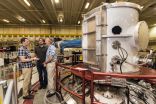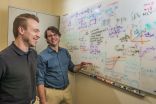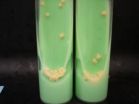(Press-News.org) ALBUQUERQUE, N.M. — Researchers at Sandia National Laboratories' Z machine have produced a significant output of fusion neutrons, using a method fully functioning for only little more than a year.
The experimental work is described in a paper to be published in the Sept. 24 Physical Review Letters online. A theoretical PRL paper to be published on the same date helps explain why the experimental method worked. The combined work demonstrates the viability of the novel approach.
"We are committed to shaking this [fusion] tree until either we get some good apples or a branch falls down and hits us on the head," said Sandia senior manager Dan Sinars. He expects the project, dubbed MagLIF for magnetized liner inertial fusion, will be "a key piece of Sandia's submission for a July 2015 National Nuclear Security Administration review of the national Inertial Confinement Fusion Program."
Inertial confinement fusion creates nanosecond bursts of neutrons, ideal for creating data to plug into supercomputer codes that test the safety, security and effectiveness of the U.S. nuclear stockpile. The method could be useful as an energy source down the road if the individual fusion pulses can be sequenced like an automobile's cylinders firing.
MagLIF uses a laser to preheat hydrogen fuel, a large magnetic field to squeeze the fuel and a separate magnetic field to keep charged atomic particles from leaving the scene.
It only took the two magnetic fields and the laser, focused on a small amount of fusible material called deuterium (hydrogen with a neutron added to its nucleus), to produce a trillion fusion neutrons (neutrons created by the fusing of atomic nuclei). Had tritium (which carries two neutrons) been included in the fuel, scientific rule-of-thumb says that 100 times more fusion neutrons would have been released. (That is, the actual release of 10 to the 12th neutrons would be upgraded, by the more reactive nature of the fuel, to 10 to the 14th neutrons.)
Still, even with this larger output, to achieve break-even fusion — as much power out of the fuel as placed into it — 100 times more neutrons (10 to the 16th) would have to be produced.
The gap is sizable, but the technique is a toddler, with researchers still figuring out the simplest measures: how thick or thin key structural elements of the design should be and the relation between the three key aspects of the approach — the two magnetic fields and the laser.
The first paper, "Experimental Demonstration of Fusion-Relevant Conditions in Magnetized Liner inertial fusion," (MagLIF) by Sandia lead authors Matt Gomez, Steve Slutz and Adam Sefkow, describes a fusion experiment remarkably simple to visualize. The deuterium target atoms are placed within a long thin tube called a liner. A magnetic field from two pancake-shaped (Helmholtz) coils above and below the liner creates an electromagnetic curtain that prevents charged particles, both electrons and ions, from escaping. The extraordinarily powerful magnetic field of Sandia's Z machine then crushes the liner like an athlete crushing a soda can, forcefully shoving atoms in the container into more direct contact. As the crushing begins, a laser beam preheats the deuterium atoms, infusing them with energy to increase their chances of fusing at the end of the implosion. (A nuclear reaction occurs when an atom's core is combined with that of another atom, releasing large amounts of energy from a small amount of source material. That outcome is important in stockpile stewardship and, eventually, in civilian energy production.) Trapped energized particles including fusion-produced alpha particles (two neutrons, two protons) also help maintain the high temperature of the reaction.
"On a future facility, trapped alpha particles would further self-heat the plasma and increase the fusion rate, a process required for break-even fusion or better," said Sefkow.
The actual MagLIF procedure follows this order: The Helmholtz coils are turned on for a few thousandths of a second. Within that relatively large amount of time, a 19-megaAmpere electrical pulse from Z, with its attendant huge magnetic field, fires for about 100 nanoseconds or less than a millionth of a second with a power curve that rises to a peak and then falls in intensity. Just after the 50-nanosecond mark, near the current pulse's peak intensity, the laser, called Z-Beamlet, fires for several nanoseconds, warming the fuel. (Z is capable of a 27-megAmp pulse. The Helmholz coils and laser were similarly operated below their maximum possible outputs.)
According to the paper's authors, the unusual arrangement of using magnetic forces both to collapse the tube and simultaneously insulate the fuel, keeping it hot, means researchers could slow down the process of creating fusion neutrons. What had been a precipitous process using X-rays or lasers to collapse a small unmagnetized sphere at enormous velocities of 300 kilometers per second, can happen at about one-quarter speed at a much more "modest" 70 km/sec. ("Modest" only comparatively; the speed is about six times greater than that needed to put a satellite in orbit.)
Schmit and Knapp
The slower pace allows more time for fusible reactions to take place. The more benign implosion also means fewer unwanted materials from the collapsing liner mix into the fusion fuel, which would cool it and prevent fusion from occurring. By analogy, a child walking slowly in the ocean's shallows stirs less mud than a vigorously running child.
Sandia senior scientist Mike Campbell said, "This experiment showed that fusion will still occur if a plasma is heated by slow, rather than rapid, compression. With rapid compression, if you mix materials emitted from the tube's restraining walls into the fuel, the fusion process won't work; also, increased acceleration increases the growth of instabilities. A thicker can [tube] is less likely to be destroyed when contracted, which would dump unwanted material into the deuterium mix, and you also reduce instabilities, so you win twice."
Besides the primary deuterium fusion neutron yields, the team's measurements also found a smaller secondary deuterium-tritium neutron signal, about a hundredfold larger than what would have been expected without magnetization, providing a smoking gun for the existence of extreme magnetic fields.
The question remained whether it was indeed the secondary magnetic field that caused the 100-fold increase in this additional neutron pulse, or some other, still unknown cause. Fortunately, the pulse has a distinct nuclear signature arising from the interaction of tritium nuclei as they slow down and react with the primary deuterium fuel, and that interaction was detected by Sandia sensors.
The secondary magnetic field is the subject of the second, theoretical paper, "Understanding fuel magnetization and mix using secondary nuclear reactions in magneto-inertial fusion." Using simulations, Sandia researchers Paul Schmit, Patrick Knapp, et al confirmed the existence and effect of extreme magnetic fields. Their calculations showed that the tritium nuclei would be encouraged by these magnetic fields to move along tight helical paths. This confinement increased the probability of subsequently fusing with the main deuterium fuel.
"This dramatically increases the probability of fusion," Schmit said. "That it happened validates a critical component of the MagLIF concept as a viable pathway forward for fusion. Our work has helped show that MagLIF experiments are already beginning to explore conditions that will be essential to achieving high yield and/or ignition in the future."
The foundation of Sandia's MagLIF work is based on work led by Slutz. In a 2010 Physics of Plasmas article, Slutz showed that a tube enclosing preheated deuterium and tritium, crushed by the large magnetic fields of the 27-million-ampere Z machine and a secondary magnetic field, would yield slightly more energy than is inserted into it.
A later simulation, published January 2012 in Physical Review Letters by Slutz and Sandia researcher Roger Vesey, showed that a more powerful accelerator generating 60 million amperes or more could reach "high-gain" fusion conditions, where the fusion energy released exceeds by more than 1,000 times the energy supplied to the fuel.
A paper led by Sefkow et al, published July 24, in Physics of Plasmas, further explicated and designed the experiments based on predictions made in Slutz's earlier paper.
But, said Campbell, "there is still a long way to go."
INFORMATION:
Sandia National Laboratories is a multi-program laboratory operated by Sandia Corporation, a wholly owned subsidiary of Lockheed Martin Corp., for the U.S. Department of Energy's National Nuclear Security Administration. With main facilities in Albuquerque, N.M., and Livermore, Calif., Sandia has major R&D responsibilities in national security, energy and environmental technologies and economic competitiveness.
Sandia magnetized fusion technique produces significant results
2014-09-23
ELSE PRESS RELEASES FROM THIS DATE:
Critically ill ICU patients lose almost all of their gut microbes and the ones left aren't good
2014-09-23
Researchers at the University of Chicago have shown that after a long stay in the Intensive Care Unit (ICU) only a handful of pathogenic microbe species remain behind in patients' intestines. The team tested these remaining pathogens and discovered that some can become deadly when provoked by conditions that mimic the body's stress response to illness.
The findings, published in mBio®, the online open-access journal of the American Society for Microbiology, may lead to better monitoring and treatment of ICU patients who can develop a life-threatening systemic infection ...
Video blinds us to the evidence, NYU, Yale study finds
2014-09-23
Where people look when watching video evidence varies wildly and has profound consequences for bias in legal punishment decisions, a team of researchers at New York University and Yale Law School has found. This study raises questions about why people fail to be objective when confronted with video evidence.
In a series of three experiments, participants who viewed videotaped altercations formed biased punishment decisions about a defendant the more they looked at him. Participants punished a defendant more severely if they did not identify with his social group and punished ...
AWHONN recommends reducing overuse of labor induction
2014-09-23
Washington, DC, September 23, 2014 —The Association of Women's Health, Obstetric and Neonatal Nurses (AWHONN) is calling upon healthcare providers and pregnant women to avoid induction of labor at any time during pregnancy unless it is medically necessary.
Approximately one-in-four U.S. births are induced, a number that has more than doubled since 1990. While there are limited data to distinguish how many of these inductions are for medical and non-medical reasons, there is no data to suggest that the significant increase in the induction rate is attributable to a similar ...
New measure provides more data on oxygen levels during sedation
2014-09-23
September 23, 2014 – The "area under the curve of oxygen desaturation" (AUCDesat) may provide a more sophisticated approach to monitoring blood oxygen levels during procedures using sedation, according to a study published in Anesthesia & Analgesia.
The AUCDesat provides information not only whether blood oxygenation has dropped too low—but also on the depth, duration, and rate of episodes of oxygen desaturation. The new study by Paul Niklewski, PhD, of University of Cincinnati and colleagues reports on the development of the AUCDesat as a potentially useful new approach ...
Termites evolved complex bioreactors 30 million years ago
2014-09-23
Achieving complete breakdown of plant biomass for energy conversion in industrialized bioreactors remains a complex challenge, but new research shows that termite fungus farmers solved this problem more than 30 million years ago. The new insight reveals that the great success of termite farmers as plant decomposers is due to division of labor between a fungus breaking down complex plant components and gut bacteria contributing enzymes for final digestion.
Sophisticated Management in Termite Fungus Farms
Fungus-farming termites are dominant plant decomposers in (sub)tropical ...
Speaking of Chemistry: Why we need antibiotics (video)
2014-09-23
WASHINGTON, Sept. 23, 2014 — Antibiotics revolutionized health care in the early 20th century, helping kill bacteria that once killed thousands of people. But bacteria are also constantly outsmarting science, and new strains of antibiotic-resistant bacteria are popping up more frequently. This week's Speaking of Chemistry focuses on the current shortage of new antibiotics and discusses the prospects for new drugs. The episode also answers the question: Why should you finish your pills if you feel better? Check it out at: http://youtu.be/MAoDuSxXIUQ.
Antibiotics are just ...
Brain wave may be used to detect what people have seen, recognize
2014-09-23
Brain activity can be used to tell whether someone recognizes details they encountered in normal, daily life, which may have implications for criminal investigations and use in courtrooms, new research shows.
The findings, published in Psychological Science, a journal of the Association for Psychological Science, suggest that a particular brain wave, known as P300, could serve as a marker that identifies places, objects, or other details that a person has seen and recognizes from everyday life.
Research using EEG recordings of brain activity has shown that the P300 ...
Researchers develop new DNA sequencing method to diagnose tuberculosis
2014-09-23
Researchers working in the UK and The Gambia, have developed a new approach to the diagnosis of tuberculosis (TB) that relies on direct sequencing of DNA extracted from sputum (a technique called metagenomics) to detect and characterize the bacteria that cause TB without the need for time-consuming culture of bacteria in the laboratory.
The research, reported today in the peer-reviewed journal PeerJ, was directed by Professor Mark Pallen, Professor of Microbial Genomics at Warwick Medical School and Dr Martin Antonio, head of the TB diagnostics laboratory at UK Medical ...
Chimpanzees raised as pets or performers suffer long-term effects on their behavior
2014-09-23
Although the immediate welfare consequences of removing infant chimpanzees from their mothers are well documented, little is known about the long-term impacts of this type of early life experience. In a year-long study, scientists from Lincoln Park Zoon observed 60 chimpanzees and concluded that those who were removed from their mothers early in life and raised by humans as pets or performers are likely to show behavioral and social deficiencies as adults.
The multi-institutional research project, published today in the open-access journal PeerJ, was led by Steve Ross, ...
Does the belief in guardian angels make people more cautious?
2014-09-23
Los Angeles, CA (September 23, 2014) While many believe that guardian angels watch over to keep them safe in a dangerous world, a new study finds that those who believe are actually less inclined to take risks despite this believed protection. This study was published today in the open access journal SAGE Open.
Researchers David Etkin, Jelena Ivanova, Susan MacGregor, and Alalia Spektor surveyed 198 individuals and found that of those who believe in guardian angels, 68% said that this belief affects how they take risks.
While some expressed that the belief in guardian ...



